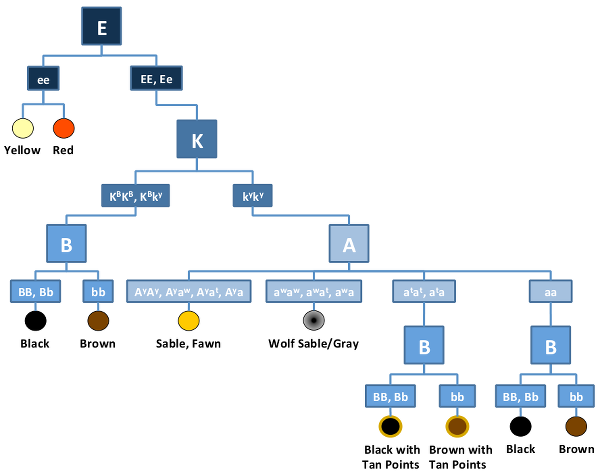Preface
First and foremost, I am including this segment of the website because there are so many questions, comments and concerns when it comes to breeding and producing the color puppies that you desire to produce, HOWEVER UNDER NO CIRCUMSTANCES WHATSOEVER DO I BELIEVE THAT COLOR SHOULD BE THE NUMBER ONE REASON FOR A PARTICULAR MATCH. I firmly, passionately and wholeheartedly believe that when planning a mating it is imperative to factor in health, temperament and structure BEFORE considering color. THIS MAY MEAN THAT that you MUST make a less than ideal color match, in favor of producing BETTER AND HEALTHIER puppies. When seeking a stud dog, PREPARE YOURSELF EARLY. It will often times take a LONG, LONG time to find an ideal match.
Courtesy of Paw Print Genetics
The above chart is the currently known color association flow chart. This is produced by Paw Print Genetics and is a perfect and accurate depiction on how the different loci interact.
Knowing what the different alleles mean and what they do is imperative to knowing this chart. Please see this page to familiarize yourself with the different alleles if you are not already familiar.
Biology 101 & Punnet Squares
Recall your 8th grade biology class. You likely discussed a man named Gregor Mendel, an Austrian Monk created as the founder of genetics. He conducted experiments breeding peas and flowers and began the foundation of knowledge regarding recessive and dominant genes.
Does this look familiar?
Breeding for color is no different than working the Punnet Square. You have parent’s alleles on the outside and you work them into the chart. Each parent can only contribute one allele to each pup. The proposed dispersion of traits is the likelihood for each pup, not the entire litter.
For Example let’s take a look at Sirius and Zelda
Remember the Flow Chart from above? Always Start with the E locus. Recall that if both parents are “e/e”, then all the offspring will be “e/e” and the rest of these exercises are not important.
In the instance of Sirius and Zelda
100% of all puppies will express a genotype of a dark coat.
After determining the E locus, the next locus that needs to be examined is the K locus. The K locus determines if the A locus is able to express. The K locus has three basic alleles.
KB - dominant solid base (black or brown)
Kbr - Brindle *this allele is not testable and when it is present the exact K locus can be flawed in presentation
ky - recessive and allows the expression of the A locus











